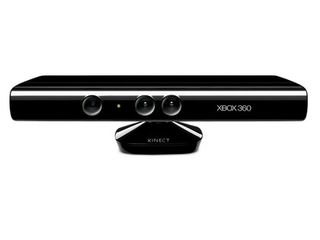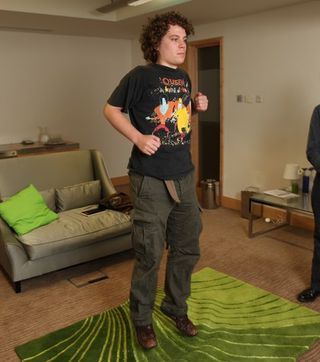Why you can trust TechRadar

There's no denying that there's some fantastic tech inside Kinect. It's an impressive system, but in order to really enjoy it, you may have to readjust your expectations with regard to what it is and what it isn't capable of.
If you're expecting to play a game and have your on-screen avatar do exactly as you do with your body, quickly, completely in sync and with no lag - you're going to be disappointed. You just can't do that in most games.
Kinect is less about having your exact real-world movements appearing on screen in real-time and more about using your body as a controller.
Take a game such as Fighters Uncaged as an example. It's a 3D Beat 'em up title where you control your fighter by performing fighting moves. But there's a significant delay between you unleashing your kicks and punches, and them being mirrored on screen.

Jump!
If you let rip with a heaving uppercut, you'll have already finished swinging before your avatar will mirror your move.
It's the same for all games. In the River Rush minigame in Kinect Adventures, you have to lean and jump in order to avoid obstacles. But your character doesn't jump perfectly in time with you - there's a split-second delay.
Across the board, with all games and apps, this delay is dependant on how fast you move. A slow, gradual movement, for example, has almost no noticeable lag at all. The faster you move, the more pronounced the lag is.
It also doesn't matter how high you jump or whether you tuck your knees in or anything like that - your on-screen avatar will just jump in the same way each time. It won't mirror your exact movements.
And that's because with most games, your movements merely trigger a pre-animated action in the game - rather than the avatars exactly mimicking you.
The first few times we played with Kinect, this bothered us a lot. It prevented us from having the kind of fun we envisioned having when Microsoft first announced the product.
But if you can get over this issue, it's not all doom and gloom.
The better news
With many games, this lag issue is actually totally irrelevant anyway.

Dance Central, for instance, from Harmonix - the makers of Guitar Hero and Rock Band - is all about skill, precision and timing. You must perform the right dance moves in time with the music and dancers on screen, in order to get a good score. Lag doesn't come into it because you're mirroring the dancers, rather than the dancers mirroring you.
Equally, there are plenty of health and fitness-themed games such as The Biggest Loser: Ultimate Workout. They're all about balance and body position rather than quick moves, flying kicks and punches.
Imagine a Yoga game where the on-screen tutor analyses your posture and tells you how to perform Downward-facing dog a bit better. Kinect is just as much about this kind of thing as it is about the hardcore action titles.
And so what it's done is make the Xbox a much more appealing console for casual gamers. This is something PlayStation Move does not offer.
Accuracy
It does take a while to get to grips with Kinect. Ignoring the lag issues with some games, the other major battle facing you is to get the hang of a new kind of hand-eye coordination.
Some people find it hard enough to catch a ball or donk a pingpong ball in real life without messing up. With Kinect, you've got to do those things on behalf of your on-screen character. You've got to transplant your thinking into the body of your avatar, timing your movements on its behalf, which is more tricky that it sounds - especially when you have to factor in the lag.
When it came to games such as Kinect Adventures throwing obstacles at us, we found ourselves wanting to wait until that obstacle reached the screen before performing the appropriate manoeuvre, rather than waiting until it reached our on-screen character. This meant we were often too late to perform the jump or sidestep.
Again, this is something which improved over time. But still, again it represents a barrier between you and the game. We wanted to feel like we were inside the games we were playing. But in general, you don't get that feeling at all - you're still just controlling a character - who isn't you - on the screen.
Once you've got the hang of it though, Kinect is perfectly accurate enough. If you mess up, you generally feel like it was your fault rather than the game not working properly.
Confusion
There were a few occasions when Kinect got rather confused. The most frequent issue we encountered was when someone stepped into view of the Kinect sensor when someone else was gaming. Occasionally Kinect would then lock on to the wrong person, which caused obvious problems. There were also a few issues with voice control.
Voice control - does it work?
Controlling something like Sky Player with voice commands is good fun and works almost perfectly.
The voice command 'Xbox' lets the console know you're going to talk to it, and the on-screen options (which bare some resemblance to the original Monkey Island command menu) pop up quickly. The Xbox more often than not did exactly as we asked it to, it's really good fun. Kids will love it.
However, that's not to say it's a perfect system, because it's not.
As you can imagine, the likelihood of someone saying the word 'Xbox' while you're fiddling with your... Xbox, is quite high. So unsurprisingly, it wasn't an uncommon occurrence for someone in the room to say "Xbox" only to trigger the Xbox's voice command feature by mistake.
This would be easily remedied if there was any kind of individual voice recognition system, where you could tell the Xbox only to respond to a specific person's voice. But unfortunately that's not possible - not yet.
Our second problem with voice control is that while it technically takes almost no effort at all to say "Xbox.... pause" when the naughty bit in Wild Things comes on, it's still a lot quicker to just grab the controller and hit the pause button with your finger.
For this reason, we can imagine many people simply abandoning the voice control system completely.
Equally, we can also see a just as many people being so fascinated by this feature that they never want to go back to their controller.
Current page: Microsoft Kinect: Performance
Prev Page Kinect review: Features Next Page Kinect review: VerdictJames was part of the TechRadar editorial team for eight years up until 2015 and now works in a senior position for TR's parent company Future. An experienced Content Director with a demonstrated history of working in the media production industry. Skilled in Search Engine Optimization (SEO), E-commerce Optimization, Journalism, Digital Marketing, and Social Media. James can do it all.


